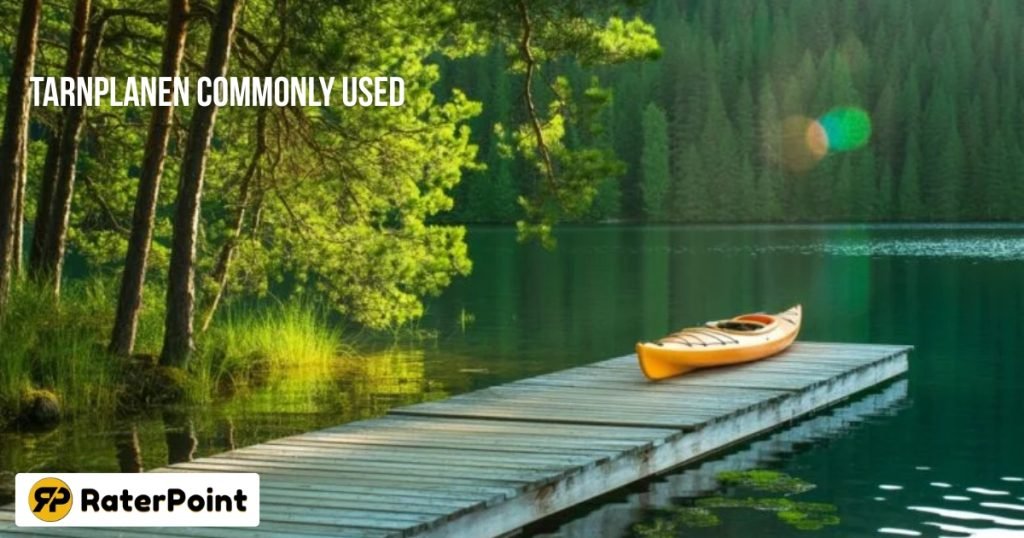What Is Tarnplanen and Why Is It Essential?

Have you ever needed a cover that withstands harsh environments while providing safety and concealment? Protection is a top priority, whether you’re working in the field, hiking, or camping. You need a way to protect your tools from the elements and prying eyes. Tarnplanen, a clever, long-lasting, reliable camouflage solution, can help with it.
The word “Tarnplanen” comes from the German language. It combines “Tarn,” meaning camouflage, and “Planen,” meaning tarpaulins or covers. Together, it translates to “camouflage tarpaulins” or “camouflage sheets.” These are used in military, outdoor, and tactical situations for concealment and protection.
You will learn about Tarnplanen and its importance in this post. We’ll examine how it functions, its applications, and how to select the best one. You’ll see why Tarnplanen is crucial for outdoor or survival needs at the end.
What Is Tarnplanen?
Strong fabric covers called tarnplanen are designed to conceal and provide protection in outdoor areas. The German terms “Tarn” (camouflage) and “Planen” (tarpaulins or coverings) are the origin of the name. These covers help blend individuals or objects into their surroundings, such as fields, forests, or even cities. They are mainly utilized for cover and protection in Germany and many other European countries.
Initially intended for military applications, tarnplanen were used to conceal personnel, equipment, and supplies. They were eventually utilized by civilians for outdoor activities, including labor, hunting, camping, and survival. These days, they have become known for their durability, water resistance, and mobility.
Materials & Design
Tarpaulins are made from tough materials such as PVC, canvas, and ripstop fabric. These materials are built to resist tearing, fading, and damage from harsh outdoor use. Many Tarnplanen include waterproof or water-resistant layers for added weather protection. They can block rain, shield against wind, and withstand the heat of strong sunlight.
Ripstop fabric features a special weave that prevents small tears from expanding. PVC-coated tarps are smooth, easy to clean, and strong against moisture and dirt. Canvas Tarnplanen feels soft but still handles rough weather and heavy outdoor use.
Unlike regular tarps, Tarnplanen come in camouflage patterns to hide gear or shelters. They are lighter, more rigid, and made for blending into forests, grasslands, or urban zones. Tarnplanen also have firm edges and grommets to make tying or hanging much easier.
Primary Purposes
Tarpaulins are primarily used to conceal and protect in various outdoor and survival situations. Military forces use them to cover gear, vehicles, and camps from enemy view. Hunters and survivalists use them to blend into nature and stay out of sight. Photographers also use them to stay hidden while capturing animals or natural scenes.
These tarps provide robust protection from rain, wind, sunlight, and varying weather conditions. Waterproof layers and tight weaves help keep people and equipment dry and safe. Tarnplanen also blocks harmful UV rays, helping gear last longer in the sun.
You can use them as shelters, ground covers, or covers for tools and vehicles. They are strong enough to handle rough use, sharp edges, and extended outdoor exposure. Tarnplanen is a wise choice for anyone needing cover that hides and protects well.
Where Is Tarnplanen Commonly Used?

Military & Tactical Use
Tarnplanen were first designed for military use to conceal camps, equipment, and vehicles. Soldiers use them to stay hidden during missions in forests, deserts, or urban areas. They help block the view from drones, aircraft, or enemy ground patrols. Many NATO and German military surplus Tarnplanen are still in use today. These military-grade tarps are strong, long-lasting, and made with advanced camouflage designs.
Outdoor & Survival Use
Outdoor enthusiasts, such as hikers, campers, and bushcrafters, often use Tarnplanen in the wild. They create fast shelters that protect from rain, wind, or strong sunlight. You can use them as ground sheets, gear covers, or simple lean-to shelters. Survivalists value them for being light, tough, and easy to pack and carry. Tarnplanen helps users blend into nature while staying dry and protected outside.
Commercial & DIY Use
Businesses use Tarnplanen to cover goods and protect them during shipping or storage. They shield products from weather damage while being moved or stored outdoors. DIY enthusiasts use them at home for roofing jobs, gardening tasks, or repair projects. Truck owners use them to protect loads from the sun, wind, and heavy rain. These tarps are a reliable tool for both work and personal outdoor projects.
Materials Used in Tarnplanen
Polyester or Nylon
Polyester and nylon are lightweight materials often used in modern Tarnplanen designs. They resist tearing, making them reliable for camping, hiking, and outdoor protection. These materials dry quickly, which helps in rainy or wet environments. Manufacturers often coat them with PVC or polyurethane for extra waterproof protection. They are also cost-effective and easy to fold, carry, and store after use.
Cotton-Blend or Canvas
Canvas or cotton-blend fabrics are used in heavier, traditional-style Tarnplanen. These materials are strong, durable, and perfect for long-term or rough outdoor setups. They offer good breathability, which helps reduce heat and moisture under the tarp. However, they can absorb water if not treated with a waterproof or repellent layer. These types are often heavier but give a natural, rugged feel and long service life.
Reinforced Eyelets and Grommets
Tarnplanen often include metal eyelets or grommets along the edges for support. These parts allow users to tie, hang, or stake the tarp safely and securely. They help keep the tarp in place during wind, rain, or heavy outdoor use. Grommets improve durability by stopping the fabric from tearing during setup or takedown. Always choose Tarnplanen with strong, rust-proof eyelets for best long-term performance.
Why Is Tarnplanen Essential?
Built to Last
Tarnplanen are designed to withstand rough use in outdoor and harsh environments. They are built with tear-resistant fabric that can withstand sharp objects and heavy winds. Waterproof coatings protect against rain, snow, and other harsh weather conditions. Tarnplanen also blocks UV rays, keeping the material strong and color from fading. Their rugged build makes them perfect for long-term use in any outdoor setting.
Adaptable in Any Situation
Tarnplanen work well in forests, deserts, mountains, cities, and even at sea. You can use them in rain, heat, cold, or windy conditions without worry. They are helpful for camping, military, survival, hunting, or home protection tasks. Both professionals and hobbyists trust Tarnplanen for safety and performance outdoors. Their flexibility makes them ideal for various needs and weather conditions.
Portability & Convenience
Tarnplanen are strong yet lightweight, making them easy to move and carry around. You can fold them small and fit them into a backpack or travel bag. They’re perfect for quick setups during hiking, emergency shelter, or fieldwork. Many users pack them for travel, survival kits, or sudden outdoor needs. They offer safety and cover without adding weight or bulk to your gear.
How to Choose the Right Tarnplanen

Size & Shape Guide
Select the size based on your specific needs for shelter, ground cover, or gear protection. Smaller tarps are suitable for single users, while larger ones are ideal for covering tents or vehicles. The shape matters too; rectangle tarps suit shelters, square ones fit gear wrapping better. Always check for strong grommets at corners and edges for easy tying and setup. Reinforced edges prevent tearing and add strength during high wind or heavy use.
Material Comparison
PVC tarps are waterproof, easy to clean, and great for prolonged outdoor exposure. Canvas is both breathable and durable, making it an ideal choice for camping or other slow-paced outdoor activities. Polyethylene is an affordable and lightweight material, making it ideal for quick shelters or home projects. For military or survival use, choose PVC or military-grade canvas for added strength. For campers or backyard tasks, polyethylene is a suitable and budget-friendly option.
Where to Buy High-Quality Tarnplanen
Always buy Tarnplanen from trusted sellers with strong product reviews and precise specs. Check if the product is marked military-grade, UV-protected, or 100% waterproof certified. Avoid low-quality copies that tear easily or fade in the sun and rain. Outdoor stores, military surplus shops, and verified online marketplaces are the best sources. Investing a bit more ensures better protection, longer lifespan, and genuine outdoor performance.
How to Use Tarnplanen Effectively
Setup Tips for Shelter
Secure each corner securely to trees or poles using paracord or sturdy ropes. To avoid tearing and maintain uniform strain on all sides, fasten ropes through grommets. Secure the corners near the ground with hefty rocks or tent stakes. To facilitate easier drainage of rainfall, position the tarp at a slight angle. Create a “ridge line” between two trees to build a fast and simple lean-to shelter. If publishing online, add simple diagrams to show tarp setup options step-by-step.
Cleaning & Maintenance Tips
Before folding the Tarnplanen, always shake off any wet leaves and dirt. Never use bleach or other harsh cleaners on the tarp; substitute cold water and mild soap. To prevent mildew, unpleasant odors, or fabric damage, let it dry completely before storage.
To prevent fading and cracking, keep the item out of direct sunlight and store it in a superb, dry location. To prevent minor damage from worsening, regularly inspect the grommets and edges for any signs of wear or damage. Even with heavy outside use, proper care can extend the lifespan of your Tarnplanen.
FAQs
What’s the difference between a tarp and a Tarnplanen?
Tarnplanen is more robust, weatherproof, and hidden than a tarp, which is a simple cover. It lasts longer than most traditional tarps, blends in with the environment, and is resistant to severe weather conditions.
Is Tarnplanen waterproof and UV-resistant?
Yes, Tarnplanen has waterproof layers and effectively protects against UV radiation. It shields equipment, people, and shelters from the elements, notably rain and sun.
Can it be used in extreme weather?
In harsh temperatures, including storms, heat, cold, and strong winds, Tarnplanen performs admirably. Its sturdy construction and innovative layout allow it to remain in place and provide adequate safety.
What size Tarnplanen should I choose for camping?
Groups typically require medium-sized or larger homes, whereas solo campers typically need modest ones. Smaller Tarnplanen are easier to carry and lighter, but larger ones provide more space.
Is it reusable for multiple seasons?
Yes, Tarnplanen can last several seasons of heavy outdoor use with proper maintenance. For a longer lifespan, clean it after use, store it dry, and quickly patch minor rips.
Final Thoughts
Tarnplanen stands out as a strong, reliable, and weather-ready cover for all situations. It offers robust protection from the sun, wind, rain, and even extreme weather situations. Its camouflage structure allows you to remain undetected while hunting, camping, or performing tactical tasks. Tarnplanen can meet your needs for outdoor covering, whether you’re a soldier, camper, or do-it-yourselfer. It is lightweight, portable, strong, waterproof, and reusable.
It can be used to protect your tools, offer a place to stay dry, or both. Its sturdy construction and clever design make it better than most common tarps. Tarnplanen continually shows its value in both wild wilderness and crowded cities.





